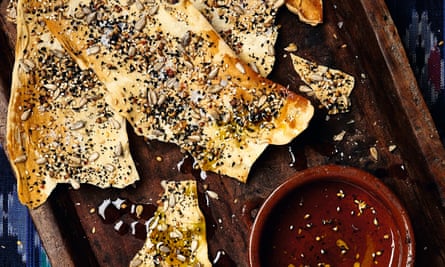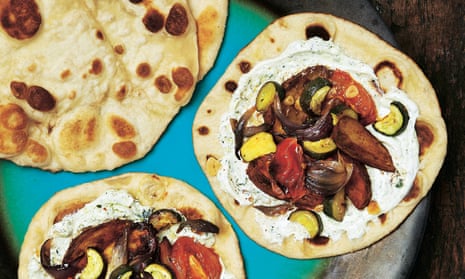Baking your own bread is pretty intimidating to some. But should it be? Yes, it takes patience and a bit of focus, and it can go wrong, but once you’ve got the hang of it, the result is second to none. This week I’m looking at flatbreads, which are ideal vehicles for countless spreads, toppings and fillings.
Lavash flatbreads with mint yoghurt and vegetables
These are messy to eat because they don’t fold perfectly like tortilla, but it’s all part of the fun. (I shouldn’t say so, but these toppings are fabulous on bought flatbread, too.) Makes eight.
1 tsp fast-action dried yeast
180ml warm water
1 tsp caster sugar
120g plain natural yoghurt
250g plain flour, plus extra for dusting
250g strong bread flour
100g ghee, for frying
Salt
For the vegetables
3 medium desiree potatoes cut into 2cm-wide wedges
60ml olive oil
1 tsp sweet smoked paprika
1 tsp ground cumin
¼ tsp dried chilli flakes
2 red onions, peeled and cut into 2cm-wide wedges
3 plum tomatoes, quartered
1 courgette, cut in half lengthways, then cut widthways into 1cm-wide slices
3 garlic cloves, peeled and finely sliced
For the mint yoghurt
350g plain natural yoghurt
½ tsp dried mint
10g mint leaves
1 tbsp olive oil
½ tsp lemon juice
For the mint yoghurt, tip the yoghurt into a sieve lined with two J-cloths, leave for an hour, then squeeze out as much liquid as you can, leaving about 200g strained yoghurt. Put both mints in a spice grinder with the oil, lemon juice and an eighth of a teaspoon of salt, blitz smooth, then stir into the yoghurt and refrigerate.
Heat the oven to 230C/450F/gas mark 8. Whisk the yeast, water and sugar in a small bowl, set aside for 15 minutes, until it starts to froth, then tip into an electric mixer with a dough hook. Add the yoghurt, flours and a teaspoon of salt, and knead slowly for two minutes, to combine; the dough will be quite dry. Turn up the speed to medium-high and knead for five minutes, until the dough is smooth yet firm. Roll into a sausage and cut into eight. Roll each piece into a ball, put on a large tray, cover with a clean tea towel and set aside to double in size (about 90 minutes).
Meanwhile, make the vegetables. Mix the potato wedges with two tablespoons of oil, half a teaspoon of salt, the paprika, cumin and chilli. Spread on a 30cm x 40cm oven tray lined with baking paper, and roast for five minutes. Push the potatoes to one half of the tray, and put the onion wedges in one of two empty corners. Drizzle with a tablespoon of oil and a quarter-teaspoon of salt, and roast for 10 minutes. Mix the tomato wedges, courgette and garlic, put them in the other empty corner, drizzle with a tablespoon of oil and a quarter-teaspoon of salt, and roast for 15 minutes, until everything is cooked and golden-brown.
While the vegetables are roasting, make the lavash. Roll each ball, one at a time, on a lightly floured surface into an 18-20cm-wide circle about 1-2mm thick. Melt a tablespoon of ghee in a nonstick frying pan on a medium-high heat, and fry the bread for three to four minutes, turning halfway, until golden-brown on both sides. Set aside, cover with a clean tea towel, and repeat with the remaining dough and ghee.
Spread the warm flatbreads with the mint yoghurt and top with the warm vegetables. Draw in the sides and bottom of the bread, to make a loose pocket, and serve.
Stuffed m’samen
Make sure your work surface and hands are well oiled, because this dough is very sticky. It’ll probably take you one or two breads to master it (there’s a lot of folding involved), but once you do, you’ll be off. Serve straight out of the pan for the crispest results. Thanks to Jessamyn Waldman Rodriguez’s The Hot Bread Kitchen Cookbook, for inspiration generally and for this recipe specifically. Makes 12, for four to six.
200g ‘00’ flour
300g plain flour
100g fine semolina, plus 50g for dusting
Salt
120ml vegetable oil, plus plenty extra for brushing
2 red onions, peeled and thinly sliced
170g mature cheddar, roughly grated
2 tsp sweet smoked paprika
4 spring onions, finely sliced
20g coriander leaves, roughly chopped
1 tbsp white-wine vinegar
80g unsalted butter
Put both flours and the semolina in an electric mixer with a dough hook. Add 400ml water, a teaspoon of salt and two teaspoons of oil, and work on low speed for two minutes, until it comes together. Turn the speed to medium-high, and beat for 10 minutes, until the dough is smooth, elastic and leaves the side of the bowl.
Transfer to an oiled work surface, rub your hands with oil and roll into a 50cm-long sausage. Cut into 12 pieces, roll each into a ball and lay on a large oiled baking tray; roll them around a bit, so they get covered in oil. Cover with clingfilm and leave to rest for 30 minutes.
For the filling, heat four teaspoons of oil in a large frying pan on a high heat. Fry the onion for nine minutes, stirring a few times, until soft and a little charred, then spoon into a bowl and mix with the cheese, paprika, spring onion, coriander, vinegar and half a teaspoon of salt.
Put 90ml oil and the butter in a small saucepan on a medium-high heat, leave to melt, then set aside.
Oil the work surface again. Taking one piece of dough at a time, press it into the palm of your hand, then roll into a thin, almost see-through 25cm-diameter circle. Put 40g of the filling (about two tablespoons) in the centre of the circle, then spread out into an 8cm-wide square. Draw the top half of the dough down over the filling, so it reaches the base of the square of filling, then draw up the bottom over this, so it meets the top edge. Now draw in the right side of the pastry, then flip over the whole package and fold in the left side. You should end up with a roughly 8cm-square pastry. Repeat with the remaining dough and filling, then sprinkle both sides of each pastry with half a teaspoon of semolina. Gently press down each pastry, so it stretches to about 15cm wide, then set aside. Don’t worry about any slight breaks: the pastry is very thin and a few nicks won’t be an issue.
Heat a tablespoon of the melted butter and oil in a frying pan on a medium-high heat. Fry the pastries one at a time for three or four minutes, turning halfway, until golden-brown, crisp and cooked through. Keep warm and repeat with the remaining pastries. Serve hot.
Crisp seeded flatbread

These are great with cheese, dips or just a glass of wine. By far the best way to make them is with a pasta machine; a rolling pin would require a lot of hard arm work, and you’ll never get the flatbreads as thin and crisp. Enlist another pair of hands to catch the dough as it comes out of the machine, otherwise it tends to crumple up. Don’t worry if you don’t have all the seeds listed: just increase the amounts of what you do have, so the total quantity comes to the same. Serves six to eight.
170g ‘00’ flour, plus extra for dusting
10g unsalted butter, at room temperature and cut in to 1cm pieces
⅓ tsp caster sugar
Flaky sea salt
1½ tbsp olive oil
1½ tbsp honey
1 tbsp nigella seeds
1½ tbsp sesame seeds
2 tbsp linseed
2 tbsp sunflower seeds
1 tbsp poppy seeds
1 tbsp coriander seeds, lightly crushed
½ tsp chilli flakes
Put the flour in a food mixer with the butter, sugar and three-quarters of a teaspoon of salt, and rub with your fingertips to disperse the butter. Add the oil and 90ml water, then knead with the dough hook on high speed for two to three minutes, until it comes together into a smooth, malleable ball (scrape the sides of the bowl once or twice, to help it along). Wrap the dough in clingfilm and rest in the fridge for 30 minutes.
Heat the oven to 180C/350F/gas mark 4 with two 30cm x 40cm baking sheets inside. Cut three pieces of baking paper to fit the trays.
Cut the dough in half and keep one half covered, to stop it drying out. With your hands, press out the dough into a 15cm x 8cm rectangle, dust with flour and feed through the pasta roller on its widest setting. Take the setting down a notch and feed through again, then repeat notch by notch until you pass it through the thinnest setting. The dough will get sticky while rolling, so dust with flour as required. Cut the piece of flat dough widthways into three, and lay two pieces on one sheet of baking paper and one on another.
Repeat with the remaining dough, so you end up with six pieces of flatbread, two on each sheet of paper.
Put the honey in a saucepan with a tablespoon and a half of water, heat to melt, and brush all over the breads. Mix the seeds with the chilli and a teaspoon of salt and sprinkle on top.
Bake in two batches (ie, do two sheets first and, once they’re done, the third one). Lift the flatbreads on their paper bases on to the hot trays and bake for nine minutes, turning the trays halfway through, until golden-brown. Set aside to cool, then break into smaller pieces – any size you like. They’ll keep in an airtight container for up to two days.

Comments (…)
Sign in or create your Guardian account to join the discussion